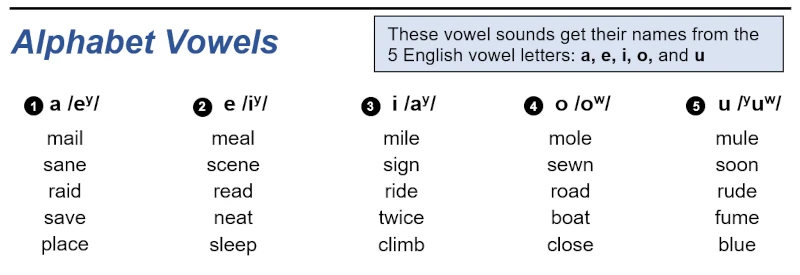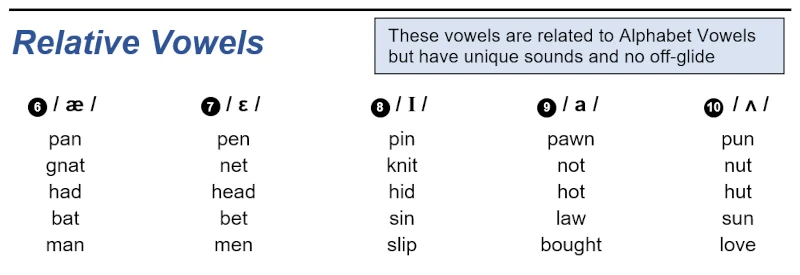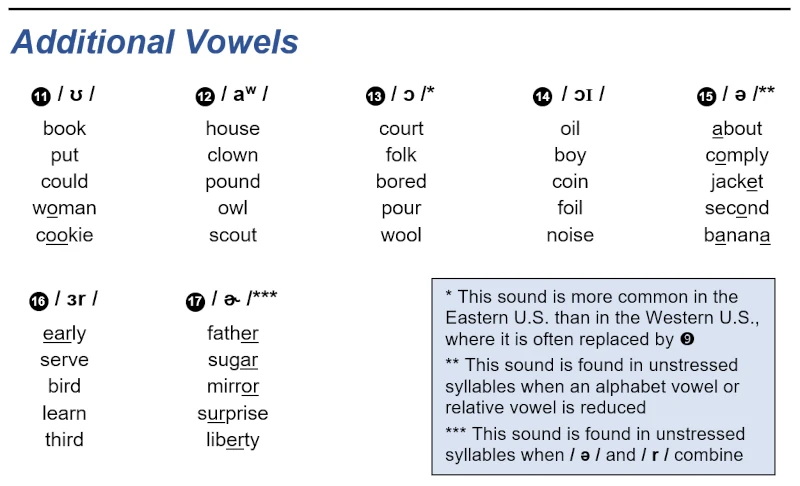American English Vowel Sounds:
American English has a large number of vowel sounds: around 20 of them! This set of sounds changes in different parts of the United States; some sounds are more popular in the Western U.S. and some are more popular in the Eastern. Fortunately, we can all (mostly) understand one another in spite of these regional differences.
For anyone who is learning American English, being familiar with vowel sounds is very important, both for listening and for speaking. In fact, vowels are one of the most important keys to clear communication.
You can download your own copy of the complete chart by clicking here:
The 17 Most Important Vowel Sounds of American English
The system you’re about to see breaks the 17 sounds into 3 different groups. Each group has its own features, and dividing vowels this way helps make them easier to understand, practice, and use in conversation.
Each section below also includes an audio track so you can listen and practice:
Group 1: The Alphabet Vowels (Numbers 1-5)
These are the 5 most familiar vowel sounds, the ones you hear when you say the English alphabet: a, e, i, o, and u. All 5 of these vowels have movement of the tongue inside of them. These tongue movements are very important for helping separate the Alphabet Vowels from some of the other vowels we will see.
The first 3 (a, e, and i) require raising the tongue at the end of the vowel. The tongue should end in a very high position, almost touching the roof of the mouth, and creating a vibration that you can feel.
The last 2 (o and u) end with the lips coming forward—almost like giving a kiss. These motions may be strange at first, but with practice, they will become easier.

Listen: The Alphabet Vowels
Group 2: The Relative Vowels (Numbers 6-10)
Each of the 5 Alphabet Vowels has a Relative—a cousin that shares some similarities while also having important differences.
The first difference of the Relative Vowels is that the tongue does not move when you form them; the tongue stays still.
Spend time noticing the differences between each sound and comparing the Relative Vowels with the Alphabet Vowels. How are #2 and #8 different? Practice pairs like “meal” and “mill” or “neat” and “knit.” Invite your tongue to try out these new, unfamiliar exercises.

Listen: The Relative Vowels
Group 3: Additional Vowels (Numbers 11-17)
This third and final group of vowels is formed mainly in two ways: They involve either combining two vowels (called a diphthong) or they involve consonants that change the sound of the vowels.
The exceptions to this are #13 and #15. Number 13 is a single vowel formed by the tongue moving back and the lips coming forward. Number 15 is a reduced, neutral sound called ‘schwa.’ Any Alphabet Vowel or Relative Vowel can change to #15 when it is not stressed inside a word.

Listen: Additional Vowels
Spend time with these vowel sounds and it is certain to make a difference in your conversations! You can download a free PDF of all 17 American English Vowel Sounds by clicking here.
Also, be sure to check out Judy Gilbert’s excellent pronunciation resource Clear Speech, 4th Edition (Available here on Amazon). You’ll find excellent practice exercises for many of the sound relationships in this article.
Thanks for reading about the importance of vowel sounds for English Pronunciation!
If you have a question or a comment, be sure to share it below.
You might also enjoy my article about 4 Steps you can take to have Confident Conversations in English
Finally, be sure to take a look at my series of articles about Understanding American Humor
Note: As an Amazon Associate, I earn from qualifying purchases, at no additional cost to you. Recommended resources are carefully selected and help support the operation of my blog, so thank you for clicking!


